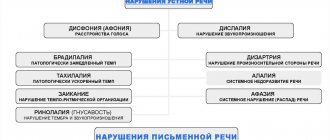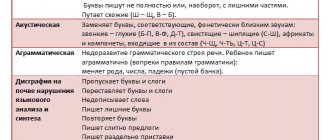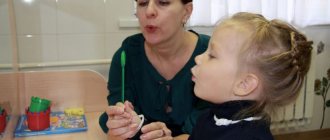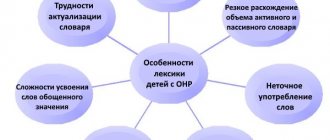Classification of dysgraphia
This is a modern classification of dysgraphia, which is considered the most substantiated. According to it, the following types of this disorder are distinguished:
- Articulatory-acoustic. Characterized by a violation of articulation of the perception of phonemic hearing. The child writes exactly the same way as he pronounces. It manifests itself in omissions and substitutions of letters in writing, which correspond to substitutions and omissions of sounds in oral speech. As a rule, it is observed with rhinolalia and dysarthria.
- Optical. Characterized by undeveloped visual-spatial perception. It is distinguished by substitutions and distortions of letters in the letter: mirror writing of letters, writing of unnecessary elements (bumps - shishshiki). Graphically similar ones are replaced, consisting of identical elements, but differently located in space (m-w, h-d).
- Acoustic. It is characterized by a violation of phonemic recognition of sounds. Letters corresponding to phonetically similar sounds are replaced, while in oral speech there are no such problems. Characterized by incorrect designation of softness in writing (“lubit”, “pismo”). Most often, hissing and whistling sounds, voiceless and voiced sounds, components and affricates are replaced.
- Based on violations of language synthesis and analysis. This type is based on a violation of various forms of synthesis and analysis. The child skips consonants when they come together (school - cola, dictation - ditant), rearranges letters (tropa - rtopa), skips vowels (dog - sbaka), adds extra letters (daskali - tasakali).
- Ungrammatical. Characterized by problems in lexical development and the development of the grammatical structure of speech. In coherent written speech, serious difficulties arise in establishing linguistic and logical connections between sentences. In other words, sentences do not always correspond to the chronology of the events described. In addition, this disorder is characterized by distortion of the morphemic structure of words, omissions of sentence parts, and incorrect use of prepositions, number, and gender. There is also a change in the case of pronouns (instead of near her - near him), the number of nouns (the dog is running), etc.
Classification of dysgraphia, developed by specialists from the department of the Russian State Pedagogical University named after A.I. Herzen, is most widely used in speech therapy practice, because when considering the basic mechanisms and manifestations of optical and language disorders in children with dysgraphia, it allows us to correlate the types of this disorder with certain correction methods that are well known to speech therapists.
⚡If you want to know how to properly teach a child to read, learn ways to prevent written language disorders, and also understand ways to correct dysgraphia and dyslexia,
take the advanced training course “MODERN Speech Pediatric TECHNOLOGIES FOR TEACHING READING, CORRECTION OF DYSLEXIA AND DYGRAPHIA IN ACCORDANCE WITH GED REQUIREMENTS”!
Receive a certificate of advanced training of the established type for 72 academic hours!
Dyslexia. Classification. Characteristics of specific errors in reading.
Dyslexia. Classification. Characteristics of specific errors in reading.
Performed :
Afonasyeva L. A.
Teacher speech therapist
Pedagogical approach
"Dyslexia
- this is a partial specific violation of the reading process, caused by the immaturity (impairment) of higher mental functions and manifested in repeated errors of a persistent nature.”
Clinical and psychological
.
“Specific reading impairments or dyslexia are conditions whose main manifestation is a persistent, selective inability to master the skill of reading, despite a sufficient level of intellectual (and speech) development for this, the absence of disorders of the auditory and visual analyzers and the presence of optimal learning conditions.
The main violation in this case is a persistent inability to master syllable fusion and automated reading of whole words, which is often accompanied by insufficient reading comprehension.
The disorder is based on disturbances in specific cerebral processes,
constituting the functional basis of reading skill.”
The term "dyslexia" refers to a group of children who have difficulties in various components of reading and writing. In accordance with the traditions of Anglo-American clinical psychology, the diagnosis of “dyslexia” implies impairments not only in reading, but also in writing. In Russian speech therapy, writing disorders have independent names: dysgraphia and
dysorphography. Despite the fact that dyslexia is the result of a person's neurobiological characteristics, it is not considered a mental illness.
In many other areas of activity, a child can show remarkable abilities. It may differ in mathematics, physics, painting or music.
The main symptoms of dyslexia: slow reading, reading syllables or letters, guessing, with errors in the form of substitutions or rearrangements of letters; understanding of the meaning of what is read is impaired to varying degrees.
Causes
Heredity
Neurobiological
underdevelopment or dysfunction of certain areas of the cerebral cortex
Neurobiological
Lack of listening and independent reading skills
in preschool and early school age, which entails insufficient development of connections between nerve cells in the speech center of the brain.
Brain injuries
Classification of dyslexia
It is based on various criteria: manifestations, degree of severity of reading disorders (R. Becker), disturbances in the activity of analyzers involved in the act of reading (O.A. Tokareva), violations of certain mental functions (M. E. Khvattsev, E. R. Levin and others), accounting for the operations of the reading process (R. I. Lalaeva).
Based on their manifestation, there are two types:
verbal
(characterized by difficulties in reading words)
literal
(due to difficulties in mastering individual letters).
Becker
notes the variety of types of reading disorders. She considers it possible to group them into the following types:
- congenital word blindness,
- dyslexia,
- bradylexia,
- letasthenia,
- congenital reading weakness .
This classification is based not on the pathogenesis of dyslexia, but
on the degree of its manifestation.
O. A. Tokareva
classifies reading disorders depending on which
of the analyzers is primarily impaired
: auditory, visual or motor. And in this regard, he identifies the forms of dyslexia:
- Acoustic
(undifferentiated auditory perception, insufficient development of sound analysis. Children have difficulty merging letters into syllables and words, since the letter is not perceived by them as a phoneme signal; they mix sounds that are similar in articulation and sound).
- Optical
(instability of visual perception and ideas. Individual letters are poorly assimilated, connections between its visual image and sound are not established, there is no clear visual image of a letter, therefore the same letter is perceived differently. Frequent confusion is observed and letters similar in outline are disrupted visual recognition of words when reading).
- Motor
difficulty moving the eyes when reading. The act of reading is carried out only under the condition of coordinated, interconnected work of the visual, auditory and motor analyzers. There is a narrowing of the visual field, frequent loss of a line or individual words in a line, and speech motor reproduction is disrupted. There is an inability to remember the necessary speech movements.
Classification of dyslexia according to the type of disordered mechanism (Khvattsev M.E.)
- Agrammatic dyslexia
- developed as a result of underdevelopment of functional and morphological generalizations, grammatical structure of speech; - Semantic
– due to unformed syllabic synthesis, lack of understanding of syntactic connections in the structure of a sentence, and poor vocabulary; - Phonemic
dyslexia – characterized by underdevelopment of phonemic perception, analysis and synthesis; - Tactile
– associated with the oddness of tactile perception in children who have poor vision; - Mnestic
- caused by a violation of speech memory, difficulty in correlating letters and sounds; - Optical
dyslexia – developed as a result of unformed visual-spatial representation.
Taking into account the disrupted operations of the reading process by R. I. Lalaev
identifies the following types of dyslexia:
- Phonemic -
associated with the underdevelopment of the functions of the phonemic system, i.e. the system of phonemes of the language, in which each unit is characterized by a certain set of semantically distinctive features.
Taking into account the immaturity of the basic functions of the phonemic system, phonemic dyslexia can be divided into two forms
.
First form
- a reading disorder associated with underdevelopment
of phonemic perception,
which manifests itself in difficulties in learning letters, as well as in substitutions of sounds that are acoustically and articulatory similar (b - p, d - t, s - sh, zh - sh, etc.).
Second form
- reading disorder caused by underdevelopment
of the phonemic analysis function
.
- Semantic dyslexia
manifests itself in a violation of the understanding of words, sentences, and texts read when reading is technically correct, i.e., the word, sentence, or text is not distorted during the reading process.
- Agrammatic dyslexia
is caused by underdevelopment of the grammatical structure of speech, morphological and syntactic generalizations.
- Mnestic dyslexia
manifests itself in difficulties in mastering all letters and in their undifferentiated substitutions. It is caused by a violation of the processes of establishing connections between sounds and letters and a violation of speech memory.
- Optical dyslexia
manifests itself in difficulties in learning and in mixing up graphically similar letters and their mutual substitutions.
With literal optical
In dyslexia, impairments are observed in isolated letter recognition and discrimination.
For verbal dyslexia
violations appear when reading a word.
- Tactile dyslexia
is observed in blind children. It is based on the difficulties of differentiating tactilely perceived Braille letters. In the process of reading, mixtures of tactilely similar letters are observed, consisting of the same number of dots, dots located mirrored (e - i, g - x), located above or below, or differing by one dot (a - b, b - l, l - To).
Dyslexia manifests itself in a slowdown in the process of mastering reading, as well as in a slower pace and speed of reading. Children with dyslexia experience disturbances in eye movement during reading. There are a large number of regressions and excessive duration of fixations. Much more significant manifestations of dyslexia are persistent and specific reading errors.
With dyslexia, the following groups of errors are noted:
1. Failure to assimilate letters, inaccurate correlation of sounds and letters,
which manifests itself in substitutions and mixtures of sounds when reading. With dyslexia, a different nature of substitutions and mixtures can be observed: a) replacements and mixtures of phonetically similar sounds (voiced and voiceless, for example TEVOCHKA, LOBATA); affricates and sounds included in their composition (for example, DADVANTIK); b) replacing graphically similar letters (X-Zh, P-N, etc.);
c) undifferentiated, variable substitutions (F-M-L, etc.).
2. Reading letter by letter
- violation of the fusion of sounds into syllables and words. With this method of reading, the letters are named one by one, “stacked”, strung one on top of the other (RAMA—Ru A, M, A).
3. Distortions of the sound-syllable structure of the word.
The most common reading errors in this group are:
a) omissions of consonants in conjunction (BENCH - KAMEKA);
b) omissions of consonants and vowels in the absence of a confluence (PAROVOS - PARVOZ);
c) adding sounds (UNDER THE RAIN - UNDER THE RAIN);
d) rearrangement of sounds (SHOVEL - LOTAL);
e) omissions, rearrangements of syllables (KANAVA - KAVANA).
4. Impaired reading comprehension,
which can manifest itself both at the level of a single word and at the level of sentences and text. Impaired reading comprehension may be primary, but it may also be secondary. In the first case, a violation of reading comprehension is observed during technically correct reading, in the second case it is a consequence of incorrect reading.
5. Word substitutions
(SWASHED - SLAMMED).
6. Agrammatisms when reading.
Most often, errors in the agreement of noun and adjective, violations of case endings, changes in verb endings, etc. are observed. Agrammatisms in reading are detected, as a rule, at the analytical-synthetic and synthetic stage of mastering the skill of reading.
The course of dyslexia is regressive in nature with a gradual decrease in the number and types of errors, as well as the degree of dyslexia.
Dyslexia negatively affects the development of a child's personality. Failures of a student in mastering reading can contribute to the emergence and consolidation of such character traits as self-doubt, timidity, anxious suspiciousness or aggressiveness, embitterment, and negativism. In some cases, these affective reactions are a consequence of dyslexia. In other cases, they are not directly related to dyslexia, but only accompany its course, being included in the general structure of neuropsychiatric diseases.
Bibliography
- Wiesel T.G. “Reading and writing impairments in children of preschool and primary school age”: Educational and methodological manual. – M.: Astrel, 2005.
- Venediktova L.V., Lalaeva R.E. “Diagnostics and correction of reading and writing disorders in primary schoolchildren. St. Petersburg: “Soyuz”, 2001.
- Kornev A.N. Dyslexia and dysgraphia in children. St. Petersburg: “Hippocrates”, 1995.
- Kornev A.N. "Dyslexia and its counterparts: criteria for differentiation." In Mat. Conf. “Study of reading and writing disorders. Results and prospects." – M.: Publishing house. Moscow Social and Humanitarian Institute, 2004.
- Kornev A.N. "Reading and writing disorders in children." St. Petersburg, 2004.
- Kornev A.N. “Key Issues of Dyslexia” St. Petersburg;
- Kornev A.N., Chirkina G.V. Current trends in the study of dyslexia in children // Defectology, 2005.
- Lalaeva R.I. reading disorders and ways to correct them in younger schoolchildren. St. Petersburg, 1998.
Thank you for your attention!






